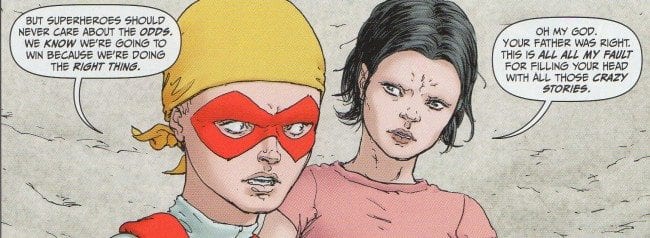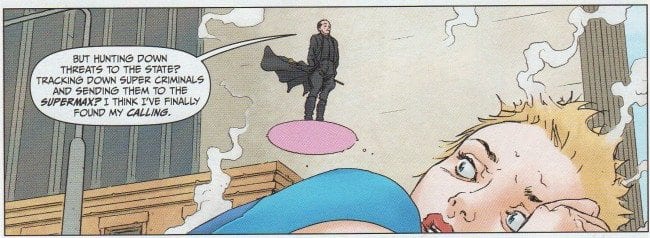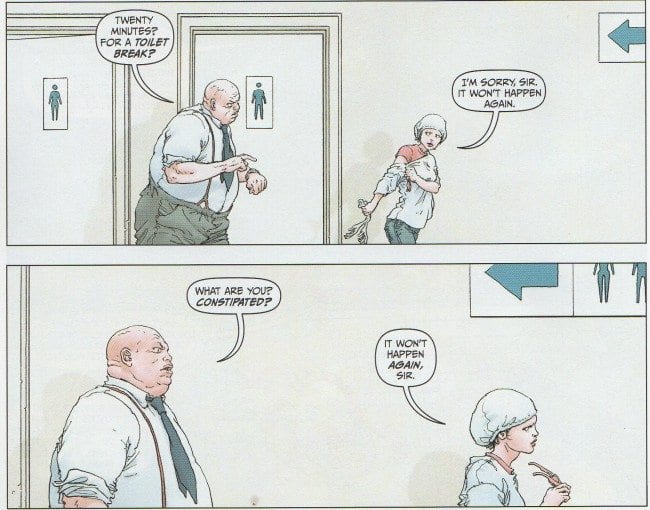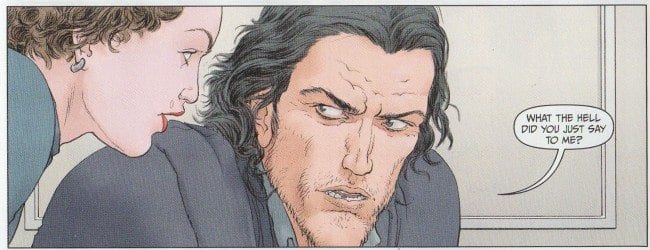LISTICLE: 10 Things About Jupiter’s Legacy #5
10. Jupiter’s Legacy is for all intents and purposes an annual comic at this point. One issue came out in 2014, and issue #5 looks to be the only one we’ll get this year (though there’s a prequel miniseries in the pipeline, so uh, yay?). For my part, I don’t mind; the annual schedule is a pretty excellent one. Provided the work is good enough, a year is a perfect amount of time to fully digest everything put on display in a comic book - from each line of dialogue to the color choices being made in each panel on down – without the general plot outline completely slipping out of mind by the time the next installment drops. Prison Pit had a great run as an annual for a bit there. So did ACME Novelty Library. John Pham’s Sublife and Epoxy are models for the format, and Alan Moore’s League of Extraordinary Gentlemen books have also favored it in recent years. And now Jupiter’s Legacy (unintentionally, due to scheduling issues) joins the ranks. Being a pamphlet-format superhero comic it’s a bit of a sore thumb in the annual crowd, but since it’s the best superhero comic I’ll let it slide. The annual format makes every issue an event, and new issues of Jupiter’s Legacy are definitely that. Especially in this extra-sized fifth issue, there’s more than enough meat to satisfy until 2016 (aka the future). This is hardly the most plotty comic anyhow: the fun part of reading it is getting hyped over all the neat little bits Mark Millar and Frank Quitely insert to elevate their superheroes-fighting-back-against-a-world-taken-over-by-the-villains story above the reams of stuff with the same general idea going on. Especially now that Quitely seems to be completely done cutting corners on his backgrounds and Millar is structuring his installments as discreet acts rather than incremental “single issues”, this is a jewel of a comic, one in which just about every panel contains an individual idea worth interrogating. Following are some of the ones I thought were noteworthy.
9. I’ll get back to Millar and Quitely in a second. They’re the main attraction here, but some significant weight is also pulled by colorist/letterer Peter Doherty (who I’m glad has really settled into his post-Libertines second act). The more pages of Doherty’s colors over Quitely I see, the more I like them. Here’s a dude who’s taken the obvious dictum that “superhero comics should be brightly colored” and done a smart, attractive job of literalizing it. Rather than girding Quitely’s hyperrealist cartooning in blunt-force primaries, Doherty instead “turns up the brightness” like a photographer would in post-production, making everything look as if it’s bathed in blinding sunlight. The result is a taffy-colored Art Nouveau dystopia, where the villains’ all black errythang looks are rendered in something closer to 60% grey, the meticulously rendered backgrounds are pushed back far enough not to distract from the action at hand, and the reds and greens of blood and foliage leap lushly off the page. Given that the tactile effect of superhero comics almost invariably fits the descriptor “clunky”, the gossamer-light adornment Doherty gently drapes around Quitely’s work is a joy, and more than a little refreshing.
- Doherty’s pulling double duty as letterer for Jupiter’s Legacy too, and while he admirably accomplishes the unenviable task of doing a job that’s designed to be noticed as little as possible by the readers, the two lettering bits in this issue that I liked most were the ones that I think might have been typos. Here they are:
I’m very partial to word balloons without punctuation at the end – it’s much truer to how spoken words actually sound. Especially here, as a grunt from a SWAT dude about to unload on a little kid (lol), it’s very apropos. “All all my fault”, meanwhile, is another nice bit of how people verbalize in real life, plus it echoes a similarly pensive moment of recrimination from another Quitely-drawn comic: “my worst, worst nightmare” from the Grant Morrison-written Batman & Robin.
If they are typos, I hope they stick around in the trade paperback version; if they aren’t, good job all around.
- The new villain introduced in this one is a cat named Barnabas Wolfe. Yeah buddy. He’s basically the asshole school security guard of your nightmares crossed with James Frain as Thomas Cromwell in The Tudors – the guy with superpowers who “didn’t really enjoy fighting crime and wasn’t really dashing enough for the magazines”, so he joined the Feds. Quitely does a good job of coding personality into his character design with the shitty mustache and leather yarmulke this dude sports, but Millar tells you everything you need to know when he reveals that Wolfe’s superhero code name used to be “The Molecule Master”. Yeah buddy. It calls to mind two also-ran Jack Kirby villains, the Molecule Man and the Miracle Man (he also sported a shitty mustache), who the Fantastic Four used to wax the floor with on the regular. Superhero names are like band names: you don’t need to listen to H∞bastank to know they suck, and you don’t have to see the Molecule Master in action to know he’s gonna get served.
- There’s a bit part in here for a woman who can turn giant-sized (her superhero name is the pretty awesome “Skyscraper” – also a good band name). Quitely uses the opportunity to squeeze in some very nice architectural drawings that have a slight Winsor McCay feel to them, but what I really like is the panels where he puts Skyscraper in the extreme foreground as the closest thing to the reader in the panel. Given the forced-perspective experiments Quitely’s indulged in before, these are nice little trompe l’oeil images that really sell the double take-inducing absurdity of a pretty young lady as tall as a corporate office tower.
- This is surely the only superhero comic of 2015 that will tread the same ground as one of last year’s finest comics, Nick Mandaag’s sidesplitting Facility Integrity. Probably also the only one you’ll see that uses the word “constipated”, too. Jupiter’s Legacy: the ColonFlow of superhero comics!
- To his obvious credit, Quitely generally avoids dropping easily identifiable “referenced” character designs into his work like a lot of superhero artists do (think Sam Jackson showing up as Nick Fury before that was in the movies, et cetera). This issue has a couple of spot on references though, whether or not it’s intentional. Given that there’s undoubtedly a Jupiter movie coming at some point, I’m hoping that Kirsten Dunst decides to throw her hat back in the blockbuster ring soon even though she’s a serious actor now:
And who better to play the annoying burnout pseudo-socialist dictator with daddy issues than… Russell Brand?
Gold.
- The action scenes continue to be the best thing about Jupiter's Legacy, as should be the case in any superhero comic. Quitely's fight choreography has never been less than masterful, but in this comic he's taken it to a new level by doing something different with it than in previous work. The kind of impact-to-impact, Jack Kirby/Frank Miller storytelling most comics use for their dynamic moments has never been Quitely's specialty. Instead, he'll often use larger, single showcase images that contain enough information for readers to piece together three or four discreet actions that have already occurred by looking over their aftereffects, usually in the same panel a final action is taking place in. Or he'll subdivide, a la Bernard Krigstein, using a profusion of smaller panels to assault the reader with a schematic view of all the component parts that make up a single, cataclysmic event like an explosion or a multi-party mêlée. Either way, it’s sequence without using the accepted tool of multiple panels strung together linearly to spell out what’s happening blow by blow.
That fundamental impulse toward a Rube Goldberg diagramming of action as a single, continuously unfolding event rather than separate puzzle pieces is still the driving force in Jupiter’s Legacy. What's new is speed. In his previous comics, Quitely's action sequences were notable for their element of flow: even in scenes where you were left to do most of the work of piecing together what had happened, every element was there, without a single leap or fired shot left to the imagination. The action in Jupiter's Legacy couldn't be more different. In this book, every action panel is its own thing entirely, with completely foreign elements bursting onto the scene without warning. In one panel a squad of cops prepares to take down their target; in the next a man stands atop a freight train as it appears from nowhere to crush them into flubber. In one panel a woman looks around at an office filled with her dead coworkers; in the next she's flying through the office window into the street. Doors blow off buses in an eyeblink. Machines are crumpled into scrap like they were piece of paper, without anyone touching them. Crashed cars rise from underwater, halfway reassembled into doomsday weapons. None of this takes more than a panel, or is followed up on in the next frame. The speed with which these events are unfolded can’t be captured by human sight, so we see everything all at once, and then the camera cuts away to the next impossibility. All we can piece together is what we see in each separate drawing. The cords between panels are cut once the fights start.
Quitely is showing us superpowers as we'd actually perceive them were they real: seemingly spontaneous eruptions of violence on a divine scale. Miracles with no explanation. It invites a sense of wonder so often missing from superhero stories, and gives us a chance to smile in approval of the ridiculous idea that’s popped up in front of us - even when it’s something we've seen countless times before in comics, like a dude getting turned into bug juice by a car wielded hammer-style. It's never possible to guess what's coming next. Often who is doing what is indicated by nothing more than the flick of a hand or a facial expression, which makes it all the sweeter when the framing slips back into classic superhero mode for just a second in order to serve up a punch by punch sequence of a dude getting his fucking face beat in.
- Quitely draws the Molecule Master’s jumpout squad all carrying rail guns that look 100% out of the Rob Liefeld playbook. This is cool for a couple of reasons. First and most obvious, that guy drew some badass guns, so he’s an excellent model to follow when badass gun drawing is an item on the agenda. This is even truer when it’s in the context of an Image-published superhero comic, a category Liefeld did nothing less than inaugurate. But it’s not the heroes in Jupiter’s Legacy carrying the Liefeld guns, it’s the guys trying to wipe every hero off the face of the planet.
If I might digress, Liefeld is an interesting figure with whom to telegraph anti-superheroism. The first wave of Image comics in the early 1990s, which Liefeld has ended up as the representative figure of, could go down in history as the moment when the commercial and aesthetic usefulness of the superhero concept found its outer limits, crashing against its barrier walls. It was the best guys from Marvel and DC coming out guns blazing with creative ownership and the freedom to do whatever they wanted, and after the initial tulip frenzy died down, that idea stood revealed as something nobody was actually that interested in buying. Youngblood and Spawn and Cyberforce and the WildC.A.T.S. barely cling to relevance as nostalgia acts these days, while the Marvel and DC characters Liefeld and company walked out on 25 years ago have swallowed pop culture whole. Nowadays the Big Two exiles who start their own books go horror or sci-fi or historical - anything that's not wearing a cape. The eventual failure of the Image founders’ superhero comics was the point at which it became obvious that there was no magic bullet to superheroes, nothing about the concept that guaranteed the kind of epochal success the Kirby characters have enjoyed. Indeed, it’s the opposite: the corporate stuff is the only stuff that’s ever going make an impact on the public consciousness, and the window for new superhero comics that can matter in that way is closed.
Maybe some innate sense of this is why "off brand" hero comics, from Watchmen on down to the very comic we're discussing now, have traditionally taken a dim view of the superhero concept, no matter how much they may have also gloried in its perks. It's human nature to lampoon ridiculous bullshit when you're not the guy getting rich off it, especially when you used to be. Jupiter's Legacy reminds me a little of work by Stanley Kubrick and B. Traven, two mercilessly effective anti-American satirists who could only make their masterpieces once they escaped residence in the target of their ire. Millar and Quitely are definitely faking the funk here, in a marquee story without any marquee corporate characters to go with it, but this is the rare superhero comic whose quality transcends its genre of origin to stand among the real comics - something the quality control folks at Marvel and DC have made more or less impossible. One of the most interesting things about Jupiter's Legacy is the tension it produces by vacillating between ridiculing and revering superheroes as a concept; a tightrope its creators are exceptionally well suited to walk because they've seen both sides of the coin.
Not that this book is a philosophical treatise or anything, but one thing I’ve really come to enjoy about it is Millar’s subtle probing of the age-old question: what exactly are superheroes supposed to do? Save people, duh, but if we’re being honest, in most superhero comics the actual saving part never gets anywhere above a tertiary narrative function (except that one part in All Star Superman that the most annoying dude in the comments section will always remind you made him cry). And “fighting evil” in these comics is made to resemble pro sports more than anything else – as the Lions play the Packers twice a year cuz it’s been that way forever, so too will Batman and the Joker square off every couple issues just cuz.
Jupiter’s Legacy, though, makes stabs at something more. They’re sporadic enough that I’m not expecting any kind of suitable-for-framing Superhero Code of Conduct to come out of this – Millar seems a lot more interested in telling a rad action story – but they pop up with enough frequency that it’s clearly not just to fill space. So far, every super-attempt to produce any greater change than a correction in the status of an unkicked ass has gone rather horribly awry in this comic, but the kind of laissez-faire, reactionary approach practiced in most superhero comics has also been shown up as pointless. Though issue #5 is mostly just a really sweet fight comic, Jupiter’s Legacy as a whole is fundamentally a comic about individuals with the power of entire nations at their disposal, and their travails in making over the world. Which is to say it’s a comic about politics, one that imagines global conflict on the scale we all kinda wish it could occur on: instantaneous, emotionally driven, entertaining, and lasting. In Jupiter’s Legacy, going around the world smacking down villains as they pop up on the radar, US foreign policy style, is not a workable approach. That’s what gets everyone else pissed enough at you to team up behind your back and melt your skull off; it’s also what lands you in the real-life financial crisis that serves as this series’ prime plot mover.
If there’s an ethos of superheroics expressed in Jupiter’s Legacy, it’s one fascinatingly similar to religious faith: unwavering belief in the justice of one’s cause, and reliance on arc of the universe’s tendency toward that justice to make up for one’s personal shortfalls, especially when all seems lost. Overwhelming odds aren’t painted in the usual dire manner here, but as an encouraging sign, a necessary prerequisite for triumph. It adds romantic warmth to a fairly cynical comic, and is hardly unwelcome as a scrap of ersatz commentary on this country’s current woes to boot. If there's a message about superheroes here, it's that they always win because they just do, and they're worth reading about because they just are; nothing too dissimilar from what you'll find in any number of terrible Batman comics. What elevates that message here is that it's earned. Jupiter's Legacy goes to no small lengths to point out all the stupid and contradictory stuff about superheroes too, and seeing the cream of the concept rise to the top despite all that in a world that so closely resembles our own is genuinely inspiring.

















